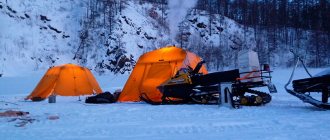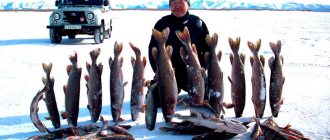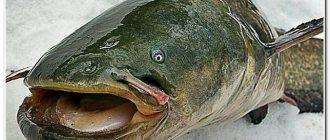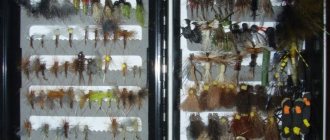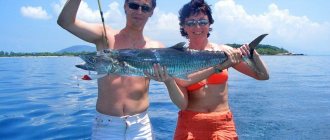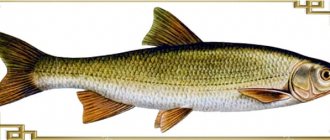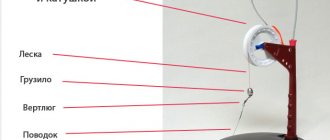In this article we will talk about tricks and unusual techniques that allow fishermen to remain with a good catch even in the most difficult conditions.
In winter, fishing conditions are often not in our favor, sometimes the weather lets us down, sometimes the fish are capricious and require a special approach. But experienced winter fishermen do not give up and persistently select the keys to capricious fish.
Winter fishing for donka from ice
Skilled fishermen in winter fishing quite often use a winter donka, the effectiveness of which is very high when fishing in the current. And even if this method of fishing does not have the courage and chic characteristic of modern gear, it cannot be taken away from its advantages. This gear is remarkable in that it can be installed in any place of the river you like - at any depth, at any current, and the bait can be held both in the middle horizons and at the bottom. In addition, the cost of making donka is minimal. Typically, fishermen install several such gear on the ice.
To make the tackle, you will need an empty spool of thick fishing line with a hole in its central part. A stick about 40 cm long and slightly smaller in diameter than the hole in the reel is cut out of a dry nut - it must rotate freely on the stick. This entire structure is placed on legs made of steel wire with a diameter of about 2 cm, similar to those used on some industrial fishing rods. When installing the tackle above the hole, the legs will not allow the reel to come into contact with water, which is undesirable in severe frost.
10-12 m of fishing line with a thickness of about 0.25 mm is wound onto a reel. The load is selected according to the force of the current and can be deaf or sliding. Hook No. 5 (according to the old number) of a dark tone with an elongated sting.
There are usually two leashes. The first, with a diameter of 0.16 mm and a length of 25 cm, is secured with a loop above the sinker to the main vein; the leash can be moved upward, allowing the bait to be at any distance from the bottom soil. Thus, a cool water horizon is quickly found (the fish can fish much higher than the bottom). If the current is strong enough (capable of pulling the leash into a straight line), then another leash with a diameter of 0.12 mm and a length of 20 cm is attached to the main vein below the sinker. The hook on such a leash is small, dark and with a small shank.
The donk is installed on the ice as follows. A sinker is lowered into the hole to the very bottom, the vein is stretched and secured to the reel in a slot, which can be made with a sharp knife. A thin flexible twig is frozen into the edge of the hole; it will act as a bite alarm. The twig is bent and its end is inserted into the corner, which is formed by a vein fixed in the slot of the bobbin. At the moment of a bite, the reel rotates and the fishing line jumps out of the slot. The rod is released and unbent - time for cutting. This is the kind of “betting” winter donk that comes out.
Choosing a place for winter fishing on a river is always a big problem, especially if the river is poorly studied. In search of cool holes, experienced fishermen often make them in a checkerboard pattern along the shore at a distance of 5-10 cm from it. If there is a suspicion that the fish is moving to depth (primarily this applies to bream fishing), then holes are drilled from the edges of the fairway or on dumps going from the shallows to the pit.
When catching bream on such donks, the fishing points are usually baited. As a rule, a feeder is used for this - a bloodworm with an opening bottom; it is filled with bloodworms and goes down into a separate hole drilled 2-3 m upstream. From hour to hour, the cord of the feeder is twitched, and the next dose of bait falls out of it.
In winter, bream is usually caught with 5-7 bloodworms or a bunch of small dung beetle worms. Sandwiches bring very good results: bloodworms along with burdock, several worms plus a couple of maggots, a bark beetle larva plus a red leech. In order to avoid idle grips, when small ruffs and silver breams are active, larger baits on larger hooks are used. Fishing in winter with donkeys naturally requires constant monitoring of gear, prompt response to bites, and regular updating of bait.
What a beginner needs for winter fishing
Preparation for winter fishing for a beginner begins with the selection of clothing equipment. At the same time, you need to understand what is required and why. Just dressing warmly is for walking around the city. A beginner’s entire fishing trip can be ruined by a frozen finger or chapped cheeks. For the convenience of monitoring the condition of your own body in the cold, from the point of view of protection, we will highlight the following critical areas, if they get wet or freeze, fishing is possible only in windless thaws, and even then not for long. If the wind picks up and even a little frost, that’s it, you’ll have to move home.
- Feet - well, you can’t let them get wet and freeze. Novice fishermen should not go on the ice without proper shoes.
- The torso itself is the main clothing, so that it does not blow and does not get wet from rain or wet snow, and in principle retains the body’s heat.
- Gloves and arm area in the fold in front of the hands. In warm, windless weather, many fishermen work without gloves. However, in this case, the cuffs of clothing, no matter what it is, must be tightly tied or tightened with an elastic band in front of the hands, so that wind and water do not get inside further into the hands, under the main protection. It’s even more so in cold and windy weather, and you also need gloves.
- Working with your own hands, constantly taking off your gloves to catch fish or re-bait, putting them on again, warming your hands, making sure they don’t freeze is the working part of any ice fishing. You need to understand that during winter fishing, your hands are constantly in the cold; this is the fisherman’s main working tool. You need to be careful not to accidentally get frostbite in the wind and frost.
- Neck and head area. It’s easier here - a good hat, a hood in case of wind, behind which you can hide almost your entire face, a high collar or a design of outerwear that reliably protects your entire neck. In windy, frosty weather, only the eyes of a novice fisherman should look out.
We caution against drinking alcoholic beverages! After consumption, it temporarily becomes warmer - but this is a deceptive illusion. Soon the blood vessels will narrow, and the body will begin to freeze more than it would when sober, and the person does not even notice this because of the hops and euphoria. It is better to warm up with hot coffee or strong tea from a thermos.
The right clothes
So, preparing for winter fishing for a beginner begins with thinking about and selecting personal clothing. Elements of personal equipment and equipment for winter fishing for beginners:
- Special shoes. The best option is PVC fishing winter boots with warm liners, as well as burkas with rubberized galoshes. In the simplest old-fashioned version - felt boots and rubber galoshes, or stockings from the Soviet army unit on top. No boots or sneakers. You can't cheat on this element. Rubber is required. First, the feet come into contact with wet slush every time a hole is drilled. Secondly, you often have to fish when there is a lot of water on the ice above, sometimes several centimeters everywhere. You can buy it at any fishing store. You need to take a larger size so that they fit freely on your foot with a warm sock and liner, but do not dangle. If it’s tight, your feet will freeze.
- Warm socks. Below are regular cotton socks, not synthetics. Synthetics can only be used for special sports ones, but it is expensive. On top - warm woolen socks.
- Thermal underwear. You can buy special winter thermal underwear - it is now available and inexpensive. The popular option is again cotton shorts and a T-shirt, and on top – something thicker, underpants or a turtleneck.
- The next layer is insulation. This could be a fleece or wool sweater. Maybe two. The more layers, the warmer, but harder to wear. Mobility decreases.
- A good option for beginners is a down or synthetic padded vest. The body is warm and the arms are mobile.
- Outerwear. The best option for beginners is a special winter suit for fishing. But this is if you have the money to buy it. If not, a regular winter jacket will do, long (to cover the butt and groin) and with a hood. Grandfather's old sheepskin coats and fur coats are also suitable - but they are heavy. Many winter roads have outerwear of the usual padded two-piece, which is easy to find - military or construction padded jackets and a pea coat.
- The outer trousers are high with suspenders rather than a belt. Special fishing or hunting, at least construction or military quilted jackets.
- Gloves - for a beginner, at least ordinary Chinese ones with synthetic padding. But better - fishing, waterproof ones. There are models with folding fingers. In relatively warm weather, thin wool ones are also suitable. It is important not to get the gloves wet - otherwise it will become impossible to use them in the cold. Therefore, it is better for a novice fisherman to have spare ones in his box.
- Hat, scarf, balaclava - at your discretion, depending on the weather, as long as your head doesn’t freeze.
The clothing for a beginner winter hiker is selected depending on the weather and fishing method. For fishing with girders and stationary fishing rods, we dress to the maximum - you will have to sit still for a long time. When actively moving with a reel or spinner, it’s easier so as not to sweat when you walk. If you start to sweat while fishing, you need to reduce your movements in speed and intensity.
You can't sweat - you'll freeze even more later. Therefore, modern clothing for fishing and hunting is preferable. The right set wicks moisture away from the body, but keeps cold and water out. These are various kinds of membranes, soft shells and other things.
We keep an eye on the brush area, especially if the angler is a beginner. It should be tightened with straps, elastic bands or the design of the outerwear itself. Further control will occur automatically. If you do not have a windproof and waterproof suit, you also need a top layer to protect against water and wind. An army slide protects from the wind, and special raincoats and capes protect from water.
Winter fishermen jokingly call themselves penguins. Take a closer look at them and you will understand why. Some are dressed in such a way that they move by swaying from side to side. And this is not without reason. It is not the one who is hardened who does not freeze, but the one who dresses well. If there is a body of water nearby that is frequented by fishermen, just take a walk and see who is wearing what and how they are equipped. At the same time, check your own clothes. If a few hours are comfortable, you can start fishing.
Oscillators in the hole
Recently, ordinary summer spoons have been increasingly used in winter fishing, and the catches of pike, large perch, and pike perch are often impressive. Experienced spinners, who have thoroughly studied the work of many spinners, believe that almost all light and medium-class spinners that were bitten in the summer are suitable for steep winter fishing - during pauses in reeling, when the spinner is gliding to the bottom.
More and more often you can see castmasters in action on the ice, both industrial and homemade models. The snag works especially effectively at depths of four meters. Even when fishing vertically, this spoon is well controlled and very stable, this allows you to perform different variants of the game not only in still water of lakes and reservoirs, but also on powerful river streams, where the castmaster does not rotate, like classic winter balancers and verticals. At moments of high activity of predatory fish, bait tossing is performed with sharp movements, with short pauses. When the fish is passive, lifts are performed smoothly, with slight acceleration, and pauses increase to 6-7 seconds.
The well-known “Atom-2” also finds its application in winter fishing, and Chinese copies of this classic bait also work well. Large pike, respectable perch, and pike perch take advantage of it. The latter responds especially well if the forend of this decoy has an edge of synthetic threads, preferably dark in color.
They play "Atom" in a somewhat unusual way. First, there is a smooth rise (about 1 m) with slight acceleration, then a release follows - at this moment the bait flies down, trembling slightly, and moves away from the center of the hole by 0.5-0.6 m. The temporary pause between rises is chosen with an eye to the activity of the predator. When the degree of its activity is low, the pauses are extended to 7 seconds. Fishing rods are used with a length of about a meter, since the lift has to be quite high, it is more convenient to work with such fishing rods. During the difficult period of deep winter, they try to raise the spoon by half a meter; at the final stage of the rise, the bait is shaken several times and only then a reset follows, followed by a pause again.
Features of winter fishing
Winter fishing
- This is fishing that involves anglers going out or going out onto the ice of reservoirs.
It would be more correct to call it ice fishing
.
It is no coincidence that in German this type of fishing is called Eisangeln (literally, Eis means ice and Angeln means fishing). Winter fishing
This is understandable, since in Germany ice in winter is very rare. And without ice, it’s just fishing in open water in cooler times. In our country, the words “winter fishing” mean fishing from ice, so winter in Russia presupposes the presence of this very ice on the reservoir. Although in recent years the expression “winter spinning” has also come into use - a rather exotic type of fishing for us.
Winter fishing is such an exciting activity that a person only needs to visit it once or twice, experience all the delights of this wonderful vacation, and that’s it. Winter fishing is a “disease”, and an incurable one!
How eagerly winter fishing enthusiasts await the start of the next season. In recent years, the weather seems to be specifically testing their nerves. Winter in the central zone comes only in December. And then a holiday comes for winter fishing lovers!
Choosing a site for winter fishing
The choice of place for fishing depends on the following: what kind of fish we need to catch. For example, pike prefers places with grass, and pike perch, in turn, avoids such places, and likes to hide behind heavy snags, stones, etc. So, information about the lifestyle and habits of the fish is not superfluous.
In winter, on ice, you can choose any point in the reservoir as a place for fishing - this is a special advantage of fishing in winter. At the same time, at this time, the underwater world, unfortunately, is closed to the fisherman, and this greatly complicates and complicates the search. Since the warm weather, a true fishing enthusiast has been looking closely at those areas where he is lucky enough to fish on ice. Vegetation in the water, current speed, depth, vector of deflected jets, shallows, rifts, islands, bottom structure (clay, sand, stones, pebbles, boulders) - everything is of interest to him, any information will be used in winter.
In certain places of the reservoir there are thickets of reeds, reeds, and horsetail. Aquatic inhabitants perceive them differently. Reeds can scare fish with their noise, and they almost never enter such places. Reeds are another matter. Among its thickets live pikes, roaches, perches and other fish - some sit out in search of prey, others hide in a safe place.
But the fish are most interested in horsetails. At the beginning of winter days, it often happens that among the thickets of horsetail, which cover large areas of the reservoir, many perches of various sizes accumulate. Horsetails also attract other fish, perhaps due to the fact that the water in such places has special properties due to alkali, and in winter there is more air in such thickets, as it penetrates the hollow stems of the plant and enriches the water. Those fish that have any damage, abrasions, scratches, enter the horsetail thickets as if they were in a hospital. In general, horsetails are a guarantee that there are fish in the reservoir. At the same time, this is a signal to the fisherman about danger, because the ice in the grass area is often less durable than in other places in the reservoir, so you need to approach reeds, horsetails, and various bushes very carefully, checking every step with an ice pick.
Choosing a site for winter fishing
“Piglet” - a relatively shallow place among impressive depths - always attracts fish. Scavengers, perches, and large-sized roaches visit such shallows from time to time; one even wonders how they ended up there. Fishing can be done both directly on the “patch” and on the approaches to it. “Fish trails” really do exist. At some times it is a ditch on an underwater plain, and at other times, on the contrary, it is something like an embankment or shaft that stretches under water in some direction. It happens that such a “path” is guessed by the vegetation, but it also happens that there is no visible vegetation on the bottom, but the fish, nevertheless, do not lose their path and even move along it according to the schedule.
If the hook takes out any greenery from the bottom, the fisherman better inspect it carefully. If it is elodea, then you can leave the hole: as a rule, only small perch and brushes, weighing no more than 20-30 grams, are pecked.
The places where the sandy strip ends and the one covered with pebbles begins are noteworthy; various bugs, larvae, etc. huddle among it - fish of various species can live here. Many fish are also attracted by riffles, just like in the summer. Below the rapids, where the depth begins and sometimes goes into ledges, you can often find large fish. At the border where the reverse and forward flow of water intersect, it is convenient to fish with a small jig: there is no current, but fish, nevertheless, can be found.
Search methods used in an unfamiliar body of water may depend on many factors: the time that can be spent fishing, the size of the reservoir and its depth, what kind of fish is preferable for fishing, the absence or presence of various devices, etc.
What is more advisable: searching for fish or waiting for its approach? This is a personal matter for the fisherman: there is no point in recommending an inspection of a large hole to someone who wants to sit and just relax in the fresh air. Such a fisherman chooses a quiet place for himself, drills several holes, feeds and patiently waits for a bite. It happens that patience is rewarded, and the catch of such a fisherman exceeds the catch of a restless fisherman who has tried many holes over the same period of time.
Drilling more than one hole in a meter of ice without checking the first for the presence of fish is advisable only in situations where there is confidence that the work will not be in vain. This approach requires either good knowledge of the reservoir, or, if the reservoir is unfamiliar, the ability to identify fishing spots based on the external environment.
Carrying out a search with depth measurements, or using any signs (openings, cracks, grass) to determine the location of anomalies in the bottom of the reservoir. And only if such a place is found, it is checked whether there is fish. You can do this in the following ways:
- The first is to quickly go through the holes with search gear, with further clarification of the fishing methods and the gear used, based on the results of the passage. For example, intensified fishing of the selected horizon, where bites are especially active or, on the contrary, searching for other bottom topography.
- The second method is much more reliable, but requires more time, which will be spent on feeding the most successful holes and waiting for the fish to come for feeding. In this case, there is a risk of wasting part or all of the complementary food in vain. So it makes sense to feed only those holes in which the presence of fish is very likely to be guessed.
- A search method in which a fisherman with ready-made gear “runs” after the intended prey is usually called running fishing. At the same time, an impressive number of holes are fished, with short delays at each. This tactic helps in checking a large area, since time is spent only on fishing and drilling a hole.
Fishing with rubber in winter
On days when the predator is “on strike”, refusing all kinds of pieces of hardware, rubber baits are used. But they catch with rubber with an end weight. The sinker is chosen to be quite heavy; it should be carried by the current below the hole no more than 4-5 m, and then remain motionless at the bottom. Above the load, at a distance of a meter and a half, attach a two-meter leash with a light jig head and twister. The weight is at the bottom, about two more meters of fishing line are unwound from the reel, and a fishing line arc is obtained. Selecting and giving it away (working with a fishing rod), they play with a twister in tandem with the current. The weight of the jig head is selected such that the bait only occasionally strikes the bottom, but most of the time it is close to it. If the current is moderate, then “lake” twisters with a long soft tail are in use, which even a weak stream does not allow to wither.
As a rule, they work on one hole for a short time (5-6 minutes), but if the edge is promising, it is known that a pike trail runs here, then they wait for the predator to come out in one place. In the final stage of fishing, they take the leash with their hand and literally tear the trophy onto the ice.
Simple jig
Often a simple jig helps the spinner to swing the hole, especially during those periods when the fish does not respond to one spinner. Everything is done like this. 2-3 turns of soft wire (copper or brass), approximately 1 mm in diameter, are wound on a regular hook with a ring and an elongated fore-end (No. 4 according to the advice number), the free ends are bitten off with wire cutters. This winding is pressed with pliers closer to the hook ring so that it cannot slip. The jig made in this way is tied to the main vein using a short leash three to four centimeters long, no longer, in order to avoid overlaps when playing. On the hook of such a jig, put a narrow strip (3 cm long), cut with sharp scissors from a damaged ripper or twister, preferably bright green.
Such a bait paired with the main spoon shows very good results in winter fishing. The distance from the vertical to the knot of the jig leash is no more than 22-23 cm. In case of a weak bite, the lion’s share of the catch comes from the jig with a rubber “fry”, which is often knocked down by predators, therefore it is always worth having the necessary supply of them in the fishing box.
Other lures use similar equipment, only on a short leash they do not have a jig, but an ordinary hook with a piece of a worm, on which not only the ubiquitous striped robber, but also a large roach sits.
Advanced Gear for Beginners
Let's touch on some more types of equipment for winter fishing, which a beginner will still purchase or use later. Maybe beginners will need some of this right away. List of minor, but sometimes necessary, winter fishing accessories for beginners:
- A tent, or at least a protective wing. This is wind protection. An ice fishing tent is good for long periods of sitting in one place. The cheapest option is a Chinese folding bed, it costs one and a half thousand, it unfolds and assembles in seconds. However, it is not stable in strong winds. The main evil when fishing in winter is the wind. Even at -30 you can sit on the ice – in the calm. However, if you’re not used to it, you won’t be able to sit in a strong wind for even an hour, even at minus 10. If you don’t have a tent and you’re a tough fisherman, you can sit simply with your back to the wind. A more comfortable option is to use a more expensive gust-resistant tent. However, if you are chasing pike perch or other fish in constant search, you don’t need a tent, since the point of fishing is to constantly move and catch new places.
- To install a tent on ice you need special screws.
- Heating in a tent - for a beginner, at least an ordinary candle or a simple gas burner. Burners should only be used in tents with ventilation or with an unfastened door, otherwise you may burn to death. Every winter, the sad statistics of fishermen who died while sleeping on the ice in Chinese non-breathable tents from the burner are replenished.
- Foam knee pads are useful for beginners during active fishing when they are biting one after another. At such moments, it is convenient to sit on your knees in front of the hole, and not on the box.
- Hook - for retrieving large fish, especially when the ice is thick. You won’t be able to pull out a bream stuck at the bottom of a hole with a meter-thick layer of ice at the end of winter.
- Extractor and yawner - useful for beginning pike hunters. Struggling to remove hooks in the toothy mouth of a predator is quite a task in the summer, and even more so in the winter.
- An echo sounder, a camera, a depth gauge - already for notorious winter roads, whose tactics are always based on studying the topography of the bottom of the reservoir.
Double strike on the perches
Skilled fishermen catch winter perch with both a balance beam and a jig. Usually, paired holes are made at promising points, the gap between them is about 50-60 cm. On one hole they fish with a fishing rod and a jig, on the other they use a balancer five to six centimeters long. If playing with a jig does not bring bites, then the fishing rod is put aside. They pick up a fishing rod with a balancer and perform 7-10 strokes - the perch often only lightly taps the bait, but is not hooked, and then they immediately switch to a jig fishing rod and, as a rule, a greedy bite follows, then another... When the bite weakens, the hole again they swing the balance beam, which also catches the striped robber, but still the bulk of the fish is brought by a jig baited with bloodworms.
Some fishermen who catch perch on lakes first actively swing the hole with a massive vertical spinner of “pike” parameters (about 7-8 cm). Then a small balancer (4 cm) comes into play, but it is not played traditionally: the rises and falls occur at a slow pace, holding the vein in a taut position. Or they simply lightly swing the snag near the very bottom soil.
In general, experienced spinners, who have been fishing with vertical spoons for many years, have noticed that the balancer often catches a vertical spoon, because in many places the fishermen have caught the predator with standard spoons, he is accustomed to the same type of game, to the same tones - silver, gold, brass, etc. . But the balancer plays completely differently in winter, and there are plenty of tones that attract fish - so they rush at it.
In winter, in reservoirs, searches for large perch are carried out using a balancer and an inversion - a float rod, which is loaded with live bait. In large reservoirs, small perch in winter often settle together with large ones, standing in the “core” of the entire school. This “core” is found with a small balancer, checking the holes one by one. When only a small sailor knocks on the snag, the hole is changed. If somewhere you managed to catch two or three solid perches in a row, then keep your ears open, especially when the bite has sharply subsided - it is quite possible that the “core” is located nearby, from which the approaching humpback broke away. But a large humpback whale often rejects a balancer - give it a live top dog or a small crucian carp. Therefore, four to five reversible fishing rods are placed in this area, which are often followed by bites from large perches.
Flipping is done in the traditional way. The handle of the fishing rod is made of foam plastic, 13-14 cm long, 4-5 cm thick. The butt, as a rule, is painted bright red, in this case the tackle is better visible when a predator turns it over. Reels for fishing line are wooden pegs inserted into foam plastic and placed on glue, or simply in slots in foam plastic. A whip on a fishing rod, about 9-10 cm long, made of vinyl plastic. A hole is drilled across the handle (about four centimeters from the base of the whip), a metal knitting needle is inserted into it, its length is ten centimeters greater than the width of the hole itself - the predator will turn it over and the fishing rod will rest against the edges of the hole. The fishing line is 0.20 mm, the sinker is a small shot, the hook is 12-15 cm from the shot.
Often in winter fishing, perch is caught with a float; in this case, the vein between the float and the rod is given slack, then there will be less chance that the striped fish, with a weak bite, will prick up its ears, swallowing live bait.
Fishing in snags
Almost all fishermen know that large fish often like to settle in thick snags. Fishing in such places with the help of a vertical spoon or balance beam, of course, is possible, but despite all the tricks and tricks, the loss of expensive baits is inevitable. But it’s one thing to tear off a cool spinner made to order by a craftsman, or an expensive balancer, and another thing to tear off an ordinary head with an elastic band. Yes, and the rubber band clings to cramps less often when fishing vertically - it knocks on the snags with its head, thereby saving the hook from a direct hook.
Playing in half-water over cramps is not always profitable (in winter, pike do not jump out from the bottom onto high-playing snags), so they try to find a clean nickel of the bottom next to the snags. The ripper on the 10-12 g head sinks to the bottom, immediately smoothly, with slight acceleration, rises half a meter and is held for a couple of seconds. Then it drops down, but literally five centimeters does not reach the bottom, then there is a second pause. This game is repeated five times. Then they begin to work like a spinner: a rather sharp rise of 30 centimeters, immediately drop down, pause for a couple of seconds. When dumping, do not hit the bottom with bait - large pike do not like this in winter.
They also fish successfully with a twister, also working as a vertical spoon, and again the pauses are short (up to 2 seconds), because the jig head, unlike a vertical one, does not move to the side and quickly calms down after being released. Usually, during the difficult period of deep winter, the effectiveness of vertical rubber drops somewhat, but in the last ice these baits become real favorites.
Winter fishing - where to start for a beginner
In addition to the varied technical component, ice fishing in winter is an endurance workout. Sometimes you need to spend the whole day in the cold, wind, and at the same time be active. A beginner needs to prepare carefully - this is not a summer fishing rod, when you can visit the reservoir in flip-flops and shorts.
To prevent ice fishing from turning into a disappointment for a beginner, you need to pay close attention not only to the fishing component - fishing rods, tactics, and fishing techniques. It is important to thoroughly prepare yourself for long-term exposure to cold and wind. At the same time, for beginners, not only clothes and fishing rods are important, but also additional elements of equipment, without which winter fishing is impossible.
Therefore, we will also consider the basic, basic accessories for winter fishing for beginners, as well as those elements that are useful, but fishing without them is, in principle, possible. Well, that is, their presence is not necessary, but it is desirable, as it significantly increases the comfort of fishing and expands the angler’s capabilities on the ice.
You need to start winter fishing not with fishing rods and tackle, but with personal equipment. Frost, wind, wet feet and frozen hands will not allow a beginner to fish normally if he does not properly prepare and think through all these nuances.
Winter fishing, unlike summer fishing, is not just fishing itself, but primarily protecting your own body from negative environmental factors. When this is done, you can spend many hours on the ice and do whatever you want.
How to tie a bulldozer correctly
The attached jig forgives a lot - tie it upside down, and the fish will still be caught with bloodworms. You don’t have to play at all – and it often takes you well when standing still. Without a nozzle, negligence does not forgive. I tied the fishing line incorrectly - and there are no bites, even if the bait itself is wonderful.
This fully applies to small bolds. It would seem that it could be simpler: pass the fishing line through the ring of one hook, through the transverse hole in the upper part of the bait, through the ring of the second hook, and tie a regular loop with a figure-eight knot. But in reality it's not that simple.
Firstly, the length of this fishing line loop must be strictly defined, in the region of 10-12 mm. Only in this case will the hooks play as they should. If the loop turns out to be longer, say, 2 cm, then when the small rod moves downwards, the hooks rise up, one is ahead of the second, moves into the corner under the knot, is clamped, and the snag begins to work with one hook, turning into an almost useless piece of metal - there are no bites at all.
Secondly, it is necessary to use a fishing line of a certain diameter. A small balda is the only bait that works significantly worse on thin fishing lines. And all because of the same movable hooks. The thinner the line, the lower its rigidity, and if the vein is too thin, under the weight of the bait, the loop tends to take the shape of a triangle - the hooks converge at the top of their rise, and the fish does not bite. With thicker line, the loop works similar to a teardrop shape, and everything is fine. By the way, it is precisely because of these important points that experienced fishermen do not see the point in the bulldozer, where a metal loop is soldered into the upper part of the snag and hooks are attached through it. They must be spaced apart, and the hole in the body of the bait helps spread them to the required distance.
This is such a “trifle”. It seems that there is such a thing here - tying a banal noose on a bulldozer, but in fact, the right decisions in this matter determine whether the fish will bite or turn up its nose, and we, in bewilderment, will attribute our failures to bad weather, inappropriate pressure, the wrong choice of bait and similar factors.
Long or short
There is often a debate on the ice about the best length of a nod. Some people advocate for long ones, while others recognize only short ones. Also important is the question of how the rod whip should be positioned during retrieving. It is clear that the ideal option is for all the wiring to be in one plane, with the whip tilted slightly downwards horizontally. When the whip is always in this position, then any nod produces the most clear, stable vibrations. However, the hand is not iron or rubber; the higher the wiring, the more you have to bend your hand, and accordingly change the position of the whip relative to the horizontal. As a result, the game begins to get confused, and the longer the nod, the more significant these glitches are - we can agree with this. If the nod is very short, around 1.5-2 cm, then these failures can be avoided almost completely. It is impossible not to agree with another advantage of short nods - with short, sharp bites, the fish itself is often detected, the implementation is a little better.
And yet, short nods have not all the advantages. Their main drawback is the limited possibilities in the variety of games! A short nod works normally only when it is significantly overloaded (a bend of 60-80 degrees), and all these “snots” play the jig too harshly, it is simply unrealistic to play softly with them, especially at shallow depths. Perch may be okay with sharp play, but roach and bream are not always so. With a long nod you can play very smoothly, softly, if desired, change the amplitude and frequency of vibrations, but the more varied the wiring, the greater the chance of a naughty fish biting. In addition, the long nod forgives minor flaws in the wiring, as if cushioning, softening, and as a result the jig plays quite stably. This point is all the more important the smaller the fishing area. After all, it’s one thing to fish a jig at depths of 6-8 m, where the friction of a long fishing line on the water also smooths out errors in the game, and quite another thing to fish at 1.5-2 m, where nodding errors are instantly transmitted to the jig.
Choosing a fishing spot
Choosing the right location for winter ice fishing is fundamental to any fishing method, both strategically and tactically. First of all, you need to answer the question of where to go fishing in winter, to which body of water. To do this, you need to understand the behavior of the fish that the angler will hunt. On this body of water itself, especially if it is large (large river, reservoir), you also need to choose the right place. During the first ice, most species stay close to the shore, at shallow depths. Even those who love pits, pike perch and bream on the first ice, can bite well at shallow depths. In the dead of winter, the fish are located deeper, in holes, on the edges. Closer to spring, underwater inhabitants return closer to coastal vegetation, enter the mouths of tributary rivers, and ascend them to spawn. Always promising fishing spots are edges, snags, patches of vegetation in great depths, underwater thickets of algae, boulders, in general any shelters and distortions of the relief. Here you already need to know and understand the features of winter fishing for a particular species.
Soft spinner for winter
Foam rubber has long been successfully used for jig fishing for pike perch in open water. What about winter fishing? Throw the same jig into the hole? Maybe, but skilled winter fishermen came up with something else, having experimented with an interesting vertical spinner - they actually catch pike perch. To do this, take an ordinary vertical pike-perch spoon and stick thin foam rubber on its upper surface. They cut it around the perimeter of the spinner, only at the ring for tying the fishing line the foam tail protrudes 1.5-2 cm. The action of the bait turns out to be easy, with a sort of laziness, the pike perch loves this.
This bait has only one drawback - in severe frosts, the water absorbed into the foam rubber instantly freezes. But any problems can be solved. So, after removing the spoon from the hole, the water can be squeezed out, and when fishing at great depths, the frozen foam should move away while the bait reaches the bottom.
Winter gear
A table for understanding who and what to catch in winter.
Traditionally, there are 5 methods of winter fishing:
- To the girders . On the girders they catch with live bait.
- An ordinary fishing rod with a nod . For fishing with balancers.
- Fishing rod with float . Variation of equipment for catching, for example, crucian carp. Used both for greater sensitivity and for fishing on the bottom in strong currents.
- Winter donka . Essential for fishing in strong currents.
- Fishing rod for trolling . An option for equipping a fishing rod with a nod for catching large fish, such as pike perch and burbot.
They are used in winter for catching predators with live bait - burbot, pike, pike perch, and perch. The advantage of zherlitsy in passive play is that the tackle can be left “activated” and left. The flag, which has come to a standing position, will notify you of a bite. This also allows you to place several girders at different holes at once. There are zerlitsy:
- On the counter;
- On the platform;
- On a tripod;
- Postavushki (under-ice girders) . Exclusively homemade stationary tackle, used as an analogue of a girder, working on the same principle, also for live bait, but all the tackle is already under water.
The basic principle of operation and design of the gear of the girder:
A reel seat, a reel with a wound line, a spring mechanism that is triggered when there is a bite, sometimes a sinker (for bottom gear for fishing in currents), a flag.
When fishing with girders, transparent fishing lines (or at least green) and light-colored hooks (for example, gray) are used to make the gear invisible.
Fishing rod with float
Winter donka
An indispensable winter fishing tackle for fishing in strong currents (for example the Volga).
Fishing with a regular nod
For fishing with a nod fishing rod, balancers and jigs with hooks No. 10-14 , depending on the size of the reservoir. Below is a tackle option for a nod fishing rod. Instead of flies, ordinary, but light jigs can be used.
Under-ice girder (supply, helicopter rig)
The bait is used mainly for catching burbot, pike, and pike perch. Line from 0.4 mm to 0.5 , leash approximately 25 cm .
Fishing rod
A fishing rod for trolling is no different from a regular nodding rod for fishing, for example, with balance beams. However, the fishing rod is equipped with a rougher nod so that there is no reaction to the flow of water. Traditionally, monofilament or fluorocarbon is used, 0.35-0.4 mm thick, colorless.
Telescopic hook for winter fishing
The hook is usually used either by larders or bettors. That is, winter roads that purposefully catch fish that often do not go into the hole. Then the large trophy turns purple and the hole widens. If you catch roach and bream with a jig, a devil, a float, or lure a perch, then fishing after fishing, the fish are usually such that they easily pass into the hole from a standard drill. And yet there are such happy moments when fate gifts fishermen with a real trophy - such a “bast shoe” lands that it is impossible to take it without the help of a hook. And here you can only rely on your habit of asking your neighbors for a boat hook. But there may be no neighbors, and besides, most winter anglers also fish without a hook.
But making a portable, convenient hook for winter fishing is not at all difficult. Its design has been known to some fishermen for a long time, but even today it does not lose its relevance. An ordinary telescopic radio antenna, which can easily be found in household junk or bought on the market, helps out. We remove the uppermost bend with the boss, and solder a large double hook into the next one. The result is a very compact hook that can be kept in your pocket and, if necessary, quickly brought into working position.
Basic equipment for a beginner subglacier
So, we are dressed and shod - we can proceed directly to the fishing equipment. What else does a beginner need for ice fishing? Regardless of the fishing method, ice fishing means drilling holes. To do this you need a special tool:
- Ice drill or pick.
- Spoon and slotted spoon for scraping out sludge.
- A folding chair, but better - a special fishing box for winter fishing with a foam seat.
- Mothworm, if we fish with baited rods.
- Feeder for bait.
- Thermos with tea or coffee.
Ice pick and ice screw
The ice pick is a piercing and chopping instrument. An ice pick can be used to make holes in thin ice. Also, in the first ice, it is the ice pick that taps the ice in front of you. An ice pick with a short handle is needed to widen the hole if necessary. However, for a beginner it is better to use an ice auger. You can buy an ax later if you need it, but a beginner is nowhere without a drill.
- A fishing drill is a rotating tool with knives at the end and an auger so that the crumbs of ice destroyed during drilling come out. With a drill you can drill through ice of any thickness, as long as the length of the handle allows.
- The drill knives have a cover. Ice auger knives are a critical point. They must be sharpened correctly. You should not hit the ice with the drill, drill into the sand, or hit the rock bottom in shallow water - novice fishermen need to be especially careful about this. You should always monitor the performance of your knives.
- There are now many different drills on the market, both ours and foreign ones. For beginners, I recommend first purchasing a Barnaul Tonar drill with an auger diameter of 130 mm. This size is universal for almost any fish. As a last resort, you can drill double or triple holes. If you only catch small things, 80-100 mm will do, it’s easier and faster to drill this way. Why Tonar? It’s simple - a set of replacement knives for it is sold in any fishing store for a ridiculous 100-200 rubles. Knives from foreign top-end drills cost the same as the entire Tonar, and you can’t quickly get them everywhere.
- When fishing, always carry a set of replacement knives and a screwdriver for replacing them (a key if they are bolted). Otherwise, if the knives fail and it is impossible to replace them on the spot, you will have to stop fishing.
Detailed article about winter drills for fishing
Skimmer
A scoop spoon with holes is used to remove slush from the hole. This is also a mandatory element of equipment. Only in rare cases can it not be used - but this is most likely not for novice anglers. But then you need a stick to form a hole in the sludge for lowering the equipment.
In cold weather, the angler constantly works with a slotted spoon to clear out the ice that forms in the holes. When fishing for girders, you can also get live bait from the canal, so as not to get your hands wet. It is better to choose a reliable spoon with a strong wooden or plastic handle. It must not drown if it accidentally gurgles into the hole.
Mothworm
When using bloodworms, it is important not to freeze the larvae. A moth box is a special polystyrene box where the larvae are stored. The box is stored in the inside pocket to keep it warm. In cold weather you need to take it out, quickly take the bloodworms and put it away again. And so every time. Only during a thaw or when fishing in a tent, if it’s warm there, you don’t have to remove the bait every time, but leave it nearby in order to quickly replant the gear.
A bloodworm costs a penny and is also available in the assortment of any fishing goods seller. At home we store it with the larvae in the refrigerator; it is also important not to spoil the bloodworms on the way to fishing. Read more about how to store bloodworms for ice fishing
Thermos and food
Perhaps not the most obvious piece of ice fishing equipment for beginners is a thermos with a hot drink and some food. However, this is important specifically for long-term exits. The body spends a lot of energy moving and staying warm. There is nothing better than a mug of hot tea in the cold, snacking on a sandwich with lard made from black bread. Some fishermen take gas burners and frying pans with them to the ice, organizing entire picnics. This is nice, but not necessary. But a beginner needs a thermos with tea, at least for the consumption of liquid to avoid dehydration.
Feeder
If you fish with a jig with a nozzle or a stationary fishing rod, you will need a feeder. Many fishing tactics require the mandatory use of bait. A regular feeder is a plastic or metal cone with holes and a lid that flips when pulled. The feeder is tied to the line of a strong fishing rod with a reel in order to lower it to the fishing point and open it at the bottom, pouring out the bait.
